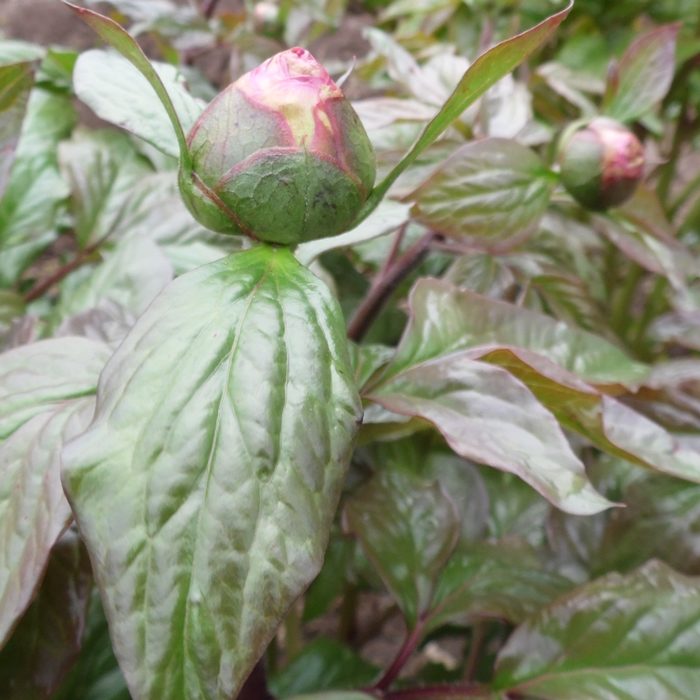About Peonies-An Overview
Get Started Growing
Peony Basics
Plant and Grow Perfectly Beautiful Peonies
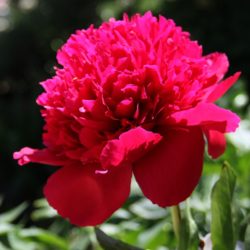
Peony Viking Valor
New to growing peonies? Knowing where to start can be overwhelming. But there’s no reason to avoid this wonderful and easy-to-grow garden plant. Unfortunately, peonies do not supply instant gratification, so don’t dawdle. The three-year “sleep, creep, leap” analogy is particularly appropriate for the peony. Yet once they are established, a peony will reward you for years to come! Peony plants can live for more than 100 years, given basic care and a good planting site.
See the American Peony Society’s Awards pages or American Peony Society Vendors for specific information about plants that may be available in commerce. These resources can be helpful in narrowing down what kinds of plants a gardener may prefer for a range of needs.
No matter the kind of peony (herbaceous, woody, Itoh or species), all have a number of shared cultural and planting requirements. See other tabs (above) and resources (below) for further information.

Mixed Peony Garden Comprised of P. lactiflora, Herbaceous Hybrid and Itoh Group Peonies
The Physical Location
Selecting a Site: Space & Drainage
- Plant peonies well away from other shrubs and trees, as the roots from these plants will compete and cause poor growth. Especially avoid black walnut trees, which produce soil toxins that prevent nearby competition. Lilacs are also problematic, as they use water and nutrients that are required by peonies.
- Avoid planting peonies where water may pool at any time of the year.
- A high position in the garden is preferred for drainage and air movement.
- Avoid planting along walls that become overly heated during the summer months.
- Peonies require dormancy in order to prosper. Planting where winter temperatures are low enough to complete dormancy is important. USDA Hardiness Zones 3-8 are generally acceptable for growing peonies.

Peonies in the Field
Above the Surface
½ Day of Sunlight or More
- Nearly all peonies require at least ½ day of sunlight and many perform best with complete exposure. A few woodland species require filtered sunlight and can be planted in shadier conditions.
- Good air movement is important to prevent disease from taking hold. Extra space should be given around the plants to aid in evaporating water from leaves and stems.
- P. lactiflora and herbaceous hybrids prefer sunnier locations with good air movement.
- Woody peonies (tree peonies) may be planted in light shade or areas that do not receive a complete day of full sunlight during the growing season.
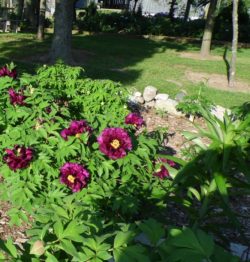
Woody Peony Along Treeline

Herbaceous Peony
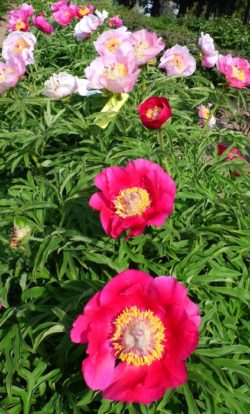
Full Sun For Most
Basics for the Roots
Well Drained, Never Wet
- A good, fertile, garden soil is best for growing peonies. Most peonies tolerate a wide range of soil types and can be expected to grow on nearly any that is supplied.
- Soil in which sand is the main constituent, may need additional amending and fertilizing for proper performance.
- All soil must be well drained and should not be subject to wet conditions at any time during the year.
- Clay soils are highly fertile and will grow peonies, but can also become compacted, causing poor drainage. Liberal amendments of organic material can help to modify this soil structure.
- Prepare soil well ahead of planting, by digging deeply (2 feet) and adding amendments throughout the growing area. Top dressing with amendments does little good.
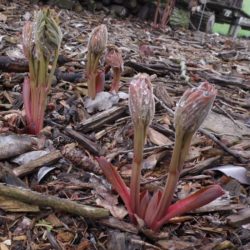
Early Spring
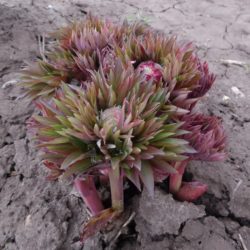
Healthy and Strong
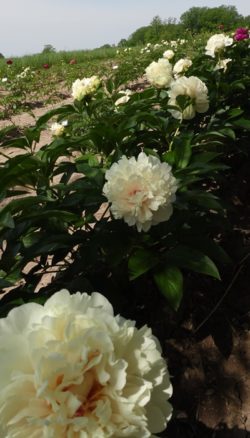
Good Soil=Good Bloom
Caution, Not Heavy Users
Seasonal Requirements Differ
- Peonies do not require abundant water throughout the year, but rather should be supplied with even moisture for best results.
- The root systems are made up of many large storage roots that help them to survive during dry periods.
- Spring and fall are periods of time in which peonies require the most moisture. In the spring months, they make vegetative growth and in fall root systems become active. Supplying peonies with water at these times of the year is important for their long term health. (Note: Mother Nature usually does a good job, but some assistance may be required in very dry years.)
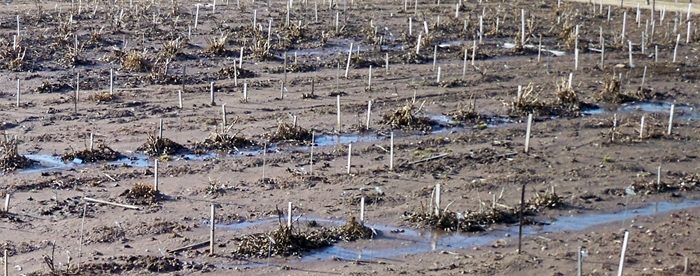
Water on Peony Field-Not So Good!
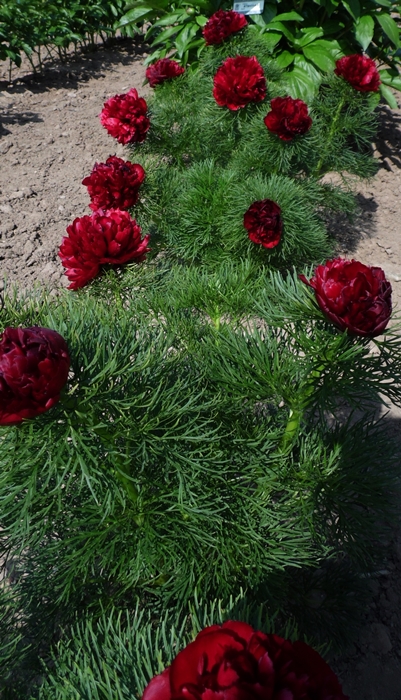
Well Drained-Somewhat Dry++
Prevention is Best Practice
Rascally Rabbits and Fungus ‘Amung’ Us
- Few animals bother to eat any part of a peony. However, woody peonies may experience rabbit damage in the winter months. Wrapping the base of the woody peony with chicken wire in the fall will prevent this.
- The main pests of peonies are fungal diseases, namely botrytis. Botrytis may infect stems and leaves, causing blackened areas and sometimes a gray mold may be accompanied. Prevention is the best method to avoid issues-cut herbaceous peonies to the ground as they begin to go dormant in the fall. Remove the foliage from the garden and place it in the trash to avoid reinfection in coming seasons. Any stems that show wilting or blackened areas should be cut out and removed to prevent spread. Fungal diseases are especially problematic during cool, wet periods in the spring.
- Mildew has been showing up on peony foliage and stems in recent years. Plants will appear to have a white colored coating, which can be washed off with some effort. While this fungus is unsightly, it does not appear to be harmful. Mildew infections are most prevalent during humid summer conditions. Fall cleanup of the garden is helpful in preventing mildew reinfection from year to year. Woody peonies are much less likely to experience mildew infections.

Botrytis At Stem Base Causes Wilting

Rabbit Damage (note uneaten stems)
Plant Care
TLC Basics
- Remove diseased foliage and stems as seen throughout the growing season
- Remove herbaceous peony stems and leaves from the garden in the fall. Plants can be cut even with the ground or a few inches of stem may be left behind.
- If water is needed, water soil around the drip line of the plant, never water the foliage.
- Bulb fertilizers are good for peonies. Avoid using fertilizers high in nitrogen, like those used for the lawn, as they cause soft-disease susceptible growth. Light fertilizer application may be done after flowering and again in late August. Apply fertilizer around the drip line of the plant. Do not fertilize, unless there is a reason to do so.
- Use of manure should be avoided, especially in close proximity to the crown and stems of the plant. Manure has been linked to the peony disease botrytis.
- Removal of spent peony blooms does not harm the plant and may produce a tidier looking planting. Simply cut them off, leaving behind the leaves, which are needed through the growing season for photosynthesis.
- Ants do not help open peony buds and are not required for their growth. They are attracted to the sugary secretions found on peony blooms. Growing peonies near the house will not cause ants to come into the home. The ant species that frequent peony blooms are dwellers of outdoor habitats and have no interest in living indoors.

